The Doctor of Nursing Practice (DNP) capstone project represents the pinnacle of your nursing education journey. Unlike traditional research dissertations, your DNP capstone project focuses on translating evidence into practice to improve patient outcomes and healthcare delivery systems. This comprehensive guide will walk you through each component of writing your DNP capstone project, providing practical examples and detailed instructions.
This step-by-step guide to nursing capstone writing will assist DNP students in navigating the complexities of their final DNP project. It presents a structured DNP process guide that outlines the essential components required for a successful project, including formulating a capstone proposal, adhering to institutional review board standards, and integrating informatics to enhance practice outcomes. Each subsection of the DNP project document is meticulously outlined, ensuring that students are well-prepared to write the project paper within the established guidelines.
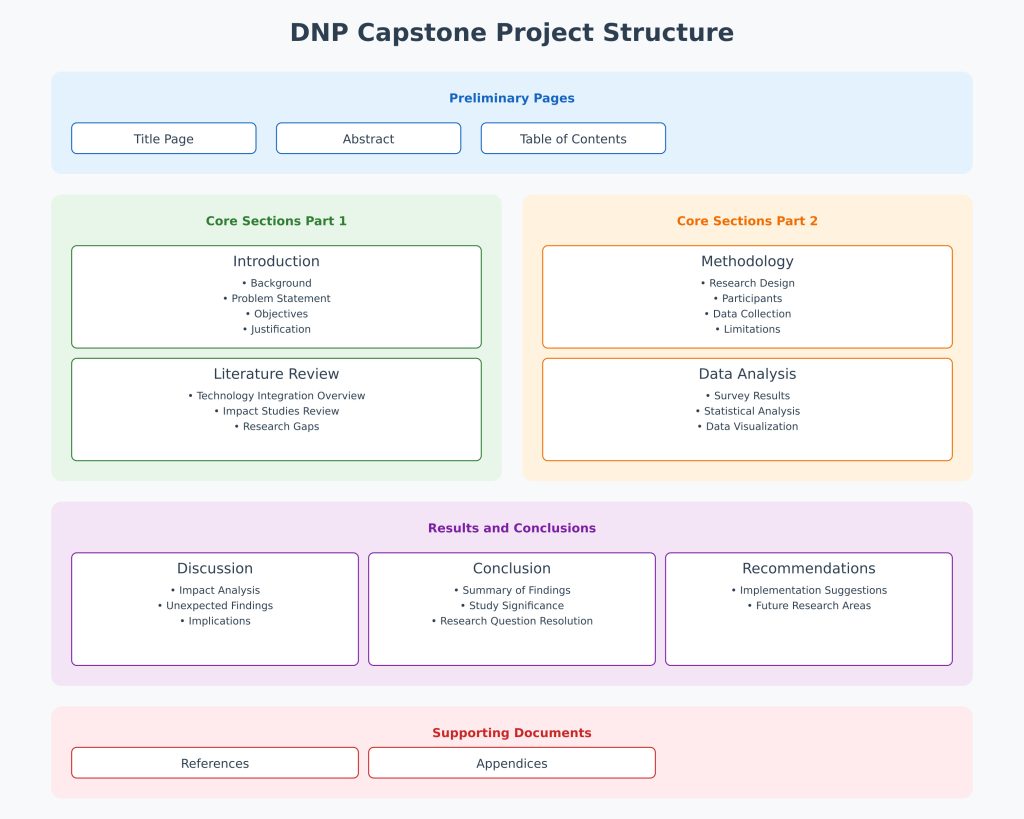
A step-by-step guide to writing a Successful DNP Capstone Project
Step 1: DNP Capstone Project Topic Selection and Planning
Before diving into writing, you need to:
1. Identify a significant practice problem in your nursing specialty
2. Ensure the problem aligns with DNP Essentials
3. Confirm the project’s feasibility within your timeframe
4. Secure support from your practice site
5. Begin assembling your capstone committee
Use this project scoping template to evaluate potential topics:
Problem Area: [Clinical issue]
Population Affected: [Target group]
Current Evidence: [Brief summary]
Potential Intervention: [Proposed solution]Feasibility Score (1-5):
- Time requirements: ___
- Resource availability: ___
- Stakeholder support: ___
- Data accessibility: ___
- Impact potential: ___
Step 2: Writing Your Title Page and Abstract
Title Development
Your title should follow this formula:
[Intervention Type] + [Population] + [Outcome] + [Setting]
Example of DNP Capstone project title:
“Implementation of a Nurse-Led Diabetic Foot Care Protocol to Reduce Amputation Rates in Rural Primary Care Clinics”
Writing an Effective Abstract
The abstract must capture your entire project in 250-350 words. Structure it as follows:
- Background (2-3 sentences)
- Purpose/Objectives (1-2 sentences)
- Methods (2-3 sentences)
- Results (2-3 sentences)
- Implications (1-2 sentences)
Example Abstract Section:
Background: Diabetic foot ulcers affect 15% of diabetic patients and lead to 85,000 amputations annually in the United States. Rural primary care clinics often lack standardized assessment protocols, resulting in delayed interventions and higher amputation rates.
Purpose: This quality improvement project implemented and evaluated a nurse-led diabetic foot care protocol to reduce amputation rates and improve early detection of foot complications in rural primary care settings.
Methods: A standardized foot assessment protocol was implemented across three rural clinics using the Iowa Model of Evidence-Based Practice. Nurses received specialized training, and screening rates were monitored over six months using electronic health record data.
Step 3: Developing the Introduction to your DNP Capstone Project
The introduction section of your DNP capstone project sets the foundation for your entire study. Think of it as a funnel that moves from a broad context to your specific research focus.
Introduction Components Breakdown
1. Background (25-30% of introduction)
2. Problem Statement (20-25%)
3. Project Objectives (20-25%)
4. Study Justification (25-30%)
Total length: 3-4 pagesWriting the Background Section
The background section states the current statistics, describes the local context, identifies the practice gap, and cites Literature on the problem identified.
Paragraph 1: Global/National Context
- Current statistics
- Relevant healthcare trends
- Policy environment
Paragraph 2: Specific Healthcare Setting
- Local context
- Institution-specific challenges
- Current practices
Paragraph 3: Gap Identification
- What's missing in current practice
- Impact on patient care
- System implicationsExample Background Opening:
“The rising prevalence of diabetes in the United States has reached epidemic proportions, affecting 34.2 million adults and costing the healthcare system $327 billion annually (CDC, 2022). Within primary care settings, diabetes management remains challenging, with only 50% of patients achieving recommended A1C targets. At Memorial Hospital’s primary care clinic, the diabetes control rate is 45%, below the national average of 55%.”
Writing the Problem Statement
Use this structure:
Despite [current intervention/practice], [specific problem] continues to affect [target population] in [setting], resulting in [negative consequences].Example Problem Statement:
“Despite standard diabetes education protocols, 55% of diabetic patients at Memorial Hospital’s primary care clinic fail to achieve A1C targets below 7%, resulting in increased complications, emergency department visits, and healthcare costs.”
Project Objectives
Structure your objectives using the SMART format:
| Component | Description | Example |
|---|---|---|
| Specific | Clear target | Implement nurse-led diabetes education |
| Measurable | Quantifiable | Reduce A1C by 2% |
| Achievable | Realistic | Within 6 months |
| Relevant | Matches need | Aligns with quality metrics |
| Time-bound | Clear timeline | Complete by December 2024 |
Example Objectives:
Primary Objective:
"To implement a nurse-led diabetes self-management education program and reduce average A1C levels by 2% among uncontrolled diabetic patients within 6 months."
Secondary Objectives:
1. Increase patient self-management knowledge scores by 50%
2. Achieve 90% nurse compliance with education protocol
3. Reduce diabetes-related ED visits by 30%Study Justification
Organize your justification using these elements:
1. Clinical Significance
- Patient impact
- Health outcomes
- Quality of life
2. Economic Impact
- Healthcare costs
- Resource utilization
- System efficiency
3. Professional Development
- Nursing practice advancement
- Staff competency
- Quality improvement
4. Healthcare Policy
- Regulatory compliance
- Quality metrics
- Value-based careExample Justification:
“This project addresses a critical gap in diabetes management while aligning with national quality metrics and value-based care initiatives. Successful implementation could reduce annual healthcare costs by $250,000, improve patient outcomes, and provide a replicable model for other primary care settings.”
Common Introduction Pitfalls to Avoid when writing your DNP Capstone Project Introduction
- Being Too Broad
❌ “Diabetes is a growing problem worldwide.”
✅ “Within our primary care clinic, uncontrolled diabetes affects 55% of patients.” - Lacking Data
❌ “Many patients struggle with diabetes management.”
✅ “Analysis of clinic data shows 158 of 287 diabetic patients (55%) have A1C >7%.” - Unclear Objectives
❌ “To improve diabetes care.”
✅ “To reduce average A1C levels by 2% through implementing a structured education program.”
Introduction Writing Checklist
Background Section:
□ Current statistics included
□ Local context described
□ Practice gap identified
□ Literature cited
Problem Statement:
□ Clear and specific
□ Supported by data
□ Impact described
□ Setting specified
Objectives:
□ SMART format used
□ Primary objective clear
□ Secondary objectives listed
□ Measurable outcomes
Justification:
□ Clinical significance
□ Economic impact
□ Professional relevance
□ Policy alignmentSample Paragraph Transitions
- From Background to Problem:
“While diabetes management guidelines emphasize patient education, implementation remains inconsistent…”
- From Problem to Objectives:
“To address this persistent gap in diabetes care, this project aims to…”
- From Objectives to Justification:
“Achievement of these objectives will significantly impact both patient outcomes and healthcare costs…”
Remember:
- Use current data (within 5 years)
- Cite credible sources
- Maintain logical flow
- Connect all elements
- Focus on your specific setting
Your introduction should leave readers with a clear understanding of:
- Why this project matters
- What specific problem you’re addressing
- How you plan to address it
- What outcomes you expect to achieve
- Why these outcomes are important
Follow this guide to create a compelling introduction that sets a strong foundation for your DNP capstone project.
Step 4: Conducting and Writing Your Literature Review
A well-crafted literature review serves as the foundation of your DNP capstone project. Think of it as creating a map of existing knowledge that will guide your project’s direction. Unlike a simple summary of articles, your literature review should tell a compelling story about what’s known in your field, identify crucial gaps in current practice, and justify your project’s significance.
Before diving into databases and search terms, take these preparatory steps:
- Define Your Scope
- What specific aspects of your topic need exploration?
- What timeframe will you consider?
- Which healthcare settings are relevant?
- Identify Key Concepts
- Break your topic into searchable elements
- Consider alternative terms and synonyms
- Think about related concepts
- Plan Your Structure
- Will you organize by themes?
- Chronologically?
- By type of intervention?
Literature Search Matrix Template
| Database | Search Terms | Filters | Results | Selected |
|----------|-------------|---------|----------|-----------|
| CINAHL | "diabetes management" AND "self-care" AND "education" | 2019-2024, English | 156 | 18 |
| PubMed | "diabetic education" AND "primary care" AND "outcomes" | 5 years, RCTs | 142 | 15 |
| Cochrane | "diabetes self-management" AND "nurse-led" | Systematic Reviews | 45 | 8 |Evidence Evaluation Table
Level of Evidence:
I - Systematic Reviews/Meta-analyses
II - Randomized Controlled Trials
III - Controlled Trials (non-randomized)
IV - Case-Control/Cohort Studies
V - Systematic Reviews of Qualitative Studies
VI - Single Qualitative/Descriptive Studies
VII - Expert Opinion/ReportsOrganizing Your Literature Review
Create Evidence Table
| Author/Year | Design | Sample | Intervention | Outcomes | Level | Key Findings |
|---|---|---|---|---|---|---|
| Smith (2023) | RCT | N=245 | Nurse-led education | A1C reduction | II | 2.1% A1C decrease |
| Jones (2022) | Cohort | N=189 | Group education | Self-management | IV | 45% improvement |
Thematic Organization
Structure your review using these categories:
- Current State of Practice
* Historical context
* Current guidelines
* Practice standards
* Implementation challenges- Evidence for Interventions
* Effectiveness data
* Implementation strategies
* Success factors
* Barriers identified- Outcome Measures
* Clinical outcomes
* Patient satisfaction
* Cost implications
* Quality metrics- Gaps in Knowledge
* Research limitations
* Practice gaps
* Implementation barriers
* Future needsWriting the Literature Review
Section 1: Introduction (1-2 paragraphs)
Example Opening:
“This literature review examines evidence regarding nurse-led diabetes self-management education in primary care settings. The search focused on studies published between 2019-2024, emphasizing randomized controlled trials, systematic reviews, and quality improvement projects.”
Section 2: Search Strategy (1 paragraph)
Example:
“A systematic search was conducted using CINAHL, PubMed, and Cochrane databases. Search terms included combinations of ‘diabetes management,’ ‘self-care education,’ ‘nurse-led interventions,’ and ‘primary care outcomes.’ Inclusion criteria specified peer-reviewed articles published within the past five years, focusing on adult populations in primary care settings.”
Section 3: Thematic Analysis
Theme 1: Current Evidence
Example Paragraph:
“Multiple randomized controlled trials demonstrate the effectiveness of nurse-led diabetes education. Smith et al. (2023) reported a 2.1% reduction in A1C levels among 245 participants receiving structured education (p<0.001). Similarly, Jones (2022) found a 45% improvement in self-management scores through group-based interventions.”
Theme 2: Implementation Strategies
Example:
“Successful implementation strategies consistently include:
- Standardized education protocols
- Regular follow-up sessions
- Multi-modal teaching approaches
- Cultural adaptation of materials”
Theme 3: Outcome Measures
Example Table:
| Outcome Category | Common Measures | Reported Impact |
|---|---|---|
| Clinical | A1C, BP, BMI | 1.5-2.5% A1C reduction |
| Behavioral | Self-management scores | 30-50% improvement |
| Economic | ED visits, costs | 25-35% reduction |
Section 4: Gap Analysis
Create a gap analysis table:
Current Knowledge:
* Effectiveness of education
* Basic implementation methods
* Short-term outcomes
Knowledge Gaps:
* Long-term sustainability
* Cost-effectiveness data
* Staff training needs
* Cultural adaptationsLiterature Review Quality Checklist
✓ Search Strategy
- [ ] Databases identified
- [ ] Search terms listed
- [ ] Inclusion/exclusion criteria
- [ ] Date ranges specified
✓ Evidence Quality
- [ ] Level of evidence noted
- [ ] Sample sizes evaluated
- [ ] Study limitations discussed
- [ ] Bias assessment included
✓ Content Organization
- [ ] Logical flow
- [ ] Thematic grouping
- [ ] Clear transitions
- [ ] Balanced coverage
✓ Writing Quality
- [ ] Proper citations
- [ ] Synthesis vs. summary
- [ ] Critical analysis
- [ ] Clear conclusions
Common Literature Review Mistakes
- Poor Organization
❌ Random presentation of studies
✓ Thematic organization with clear transitions - Lack of Synthesis
❌ Study-by-study summary
✓ Integration of findings across studies - Outdated Sources
❌ Over-reliance on old research
✓ Current evidence with historical context - Missing Analysis
❌ Descriptive summaries only
✓ Critical evaluation of evidence
DNP Capstone Project Writing Tips and Examples
Synthesis Example
Weak:
“Smith (2023) found improved outcomes. Jones (2022) also found improvements.”
Strong:
“Multiple studies demonstrate consistent improvements in A1C levels through nurse-led education, with reductions ranging from 1.5-2.5% (Smith, 2023; Jones, 2022).”
Critical Analysis Example
Weak:
“The study showed positive results.”
Strong:
“While the intervention showed promising A1C reductions, the small sample size and short follow-up period limit generalizability. Future studies should examine long-term outcomes in diverse populations.”
Transition Examples
Between themes:
“Having established the effectiveness of nurse-led education, consideration of implementation strategies is crucial…”
Concluding paragraph:
“This review reveals strong evidence for nurse-led diabetes education while highlighting the need for research on long-term sustainability and cost-effectiveness.”
Remember: Your literature review should tell a compelling story about what’s known, what works, what doesn’t, and what’s needed in your area of study.
Step 5: Writing the Methodology Section of Your DNP Capstone Project
The methodology section serves as your project’s blueprint, providing a detailed roadmap of how you’ll conduct your quality improvement initiative or evidence-based practice change. This section should be so clear that another healthcare professional could replicate your project.
Structure of the Methodology Section
1. Research Design (20% of section)
2. Setting and Participants (20%)
3. Data Collection Methods (30%)
4. Implementation Plan (20%)
5. Limitations and Ethics (10%)Research Design Framework
Start with a clear description of your design approach:
| Design Type | When to Use | Example |
|---|---|---|
| Quality Improvement | Process/outcome improvement | Reducing ED wait times |
| Evidence-Based Practice | Implementing best practices | New diabetes protocol |
| Program Evaluation | Assessing existing programs | Telehealth effectiveness |
| Mixed Methods | Complex interventions | Staff education program |
Example Research Design Statement:
“This quality improvement project utilizes a pre-post intervention design to evaluate the implementation of a nurse-led diabetes education protocol in primary care. The project follows the PDSA (Plan-Do-Study-Act) methodology for continuous quality improvement.”
Setting and Participants Section
Create a detailed description using this framework:
Setting Description:
* Facility type
* Department/unit
* Geographic location
* Patient demographics
* Current practices
Participant Details:
* Target population
* Inclusion criteria
* Exclusion criteria
* Sampling method
* Sample size calculationExample Setting Description:
“The project will be implemented in a 250-bed community hospital’s medical-surgical unit serving a diverse urban population. The unit handles approximately 2,500 patient admissions annually, with 30% being diabetes-related admissions.”
Data Collection Methods
Organize your data collection plan:
| Measure Type | Data Source | Collection Method | Frequency | Responsible Party |
|---|---|---|---|---|
| A1C Levels | EMR | Chart Review | Monthly | Project Lead |
| Patient Knowledge | Survey | Paper/Electronic | Pre/Post | Staff Nurse |
| Staff Compliance | Checklist | Direct Observation | Weekly | Unit Manager |
Example Data Collection Statement:
Primary Outcome Measures:
1. Clinical Outcomes
• A1C levels (baseline and 3 months)
• Blood pressure readings
• BMI measurements
2. Process Measures
• Education completion rates
• Protocol adherence
• Documentation compliance
3. Balancing Measures
• Staff satisfaction
• Time requirements
• Resource utilizationImplementation Plan
Create a detailed timeline:
Phase 1: Preparation (Weeks 1-4)
* Staff training
* Resource development
* Baseline data collection
* Protocol finalization
Phase 2: Implementation (Weeks 5-16)
* Protocol rollout
* Weekly monitoring
* Data collection
* Staff feedback
Phase 3: Evaluation (Weeks 17-24)
* Data analysis
* Outcome assessment
* Report development
* Sustainability planningData Analysis Plan
Specify your analysis methods:
Quantitative Analysis:
* Descriptive statistics
* Pre-post comparisons
* Statistical tests
* Effect size calculations
Qualitative Analysis:
* Thematic analysis
* Content coding
* Pattern identification
* Quote selectionEthical Considerations and Limitations
Address key considerations:
Ethics:
* IRB approval/exemption
* Consent process
* Data security
* Privacy protection
Limitations:
* Sample size
* Time constraints
* Resource limitations
* GeneralizabilityQuality Assurance Checklist for Methodology Section
✓ Research Design
- [ ] Design type specified
- [ ] Framework described
- [ ] Rationale provided
- [ ] Timeline included
✓ Setting/Participants
- [ ] Setting described
- [ ] Population defined
- [ ] Inclusion/exclusion criteria
- [ ] Sample size justified
✓ Data Collection
- [ ] Measures specified
- [ ] Tools described
- [ ] Procedures detailed
- [ ] Timeline outlined
✓ Analysis Plan
- [ ] Methods specified
- [ ] Software identified
- [ ] Tests described
- [ ] Significance levels
Common Methodology Pitfalls to Avoid
- Insufficient Detail
❌ “We will collect data monthly.”
✓ “A1C levels will be collected monthly through EMR review using a standardized data extraction tool.” - Unclear Procedures
❌ “Staff will be trained on the protocol.”
✓ “Staff will complete a 2-hour training session covering protocol implementation, documentation requirements, and patient education techniques.” - Missing Rationale
❌ “Survey tools will be used.”
✓ “The validated Diabetes Knowledge Test (DKT) will be used to assess patient understanding pre- and post-intervention.”
Example Methodology Templates
For Quality Improvement Projects:
1. Quality Framework
• PDSA cycle description
• Improvement metrics
• Feedback mechanisms
2. Implementation Strategy
• Staff engagement plan
• Resource allocation
• Communication plan
• Monitoring systemFor Evidence-Based Practice Projects:
1. Practice Change Model
• Iowa Model
• Johns Hopkins Model
• ARCC Model
2. Implementation Steps
• Evidence synthesis
• Protocol development
• Staff training
• Outcome measurementFinal Tips for Success
- Be Specific with the details of the methodology
- Include exact numbers
- Define time periods
- Specify rolesDetail procedures
- Maintain Alignment
- Link to objectives
- Connect to outcomes
- Follow framework
- Consider limitations
- Ensure Replicability
- Clear procedures
- Detailed steps
- Resource requirements
- Timeline specifics
Your methodology section should provide a clear, detailed roadmap for implementing your project. Someone reading this section should be able to understand exactly how you plan to conduct your project and why you chose these specific methods.
Step 6: Writing the Data Analysis Section of Your DNP Capstone Project
The data analysis section of your DNP capstone project requires a clear, systematic description of how you processed and interpreted your project data. This section must demonstrate both statistical rigor and clinical relevance.
Structure of DNP Data Analysis Section
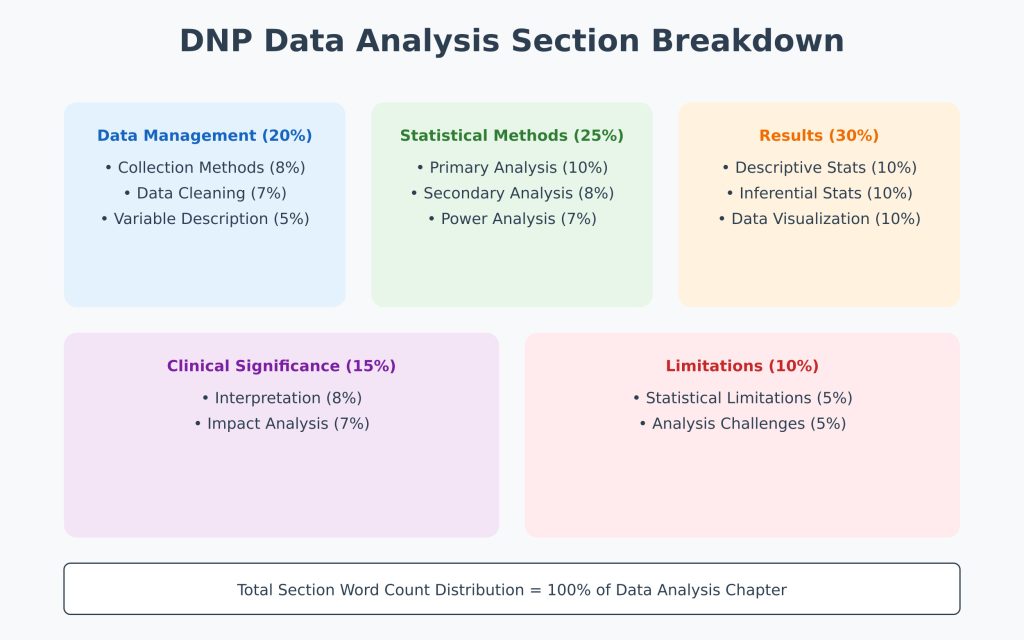
Data Collection and Preparation
Begin by describing your data collection process:
“Data collection occurred over 12 weeks from September to December 2024. The process included daily blood pressure measurements, weekly medication adherence surveys, and monthly quality of life assessments. All data were entered into REDCap within 24 hours of collection.”
Include your data cleaning procedures:
Data Preparation Steps:
1. Daily data verification
2. Missing data assessment
3. Outlier identification
4. Data normality testing2. Quantitative Analysis Methods
Describe your statistical approach clearly:
“Primary outcome analysis employed paired t-tests to compare pre- and post-intervention blood pressure readings. Secondary analyses included:
- Descriptive statistics for demographic data
- Chi-square tests for categorical variables
- Repeated measures ANOVA for longitudinal data
- Multiple regression for predictive factors”
Example Statistical Table:
| Analysis Type | Variables | Test Used | Significance Level |
|---|---|---|---|
| Primary | BP Changes | Paired t-test | p < 0.05 |
| Secondary | Demographics | Chi-square | p < 0.05 |
| Correlation | Age vs. BP | Pearson’s r | p < 0.01 |
3. Results Presentation
Present your findings systematically:
“Pre-intervention systolic BP averaged 145mmHg (SD=12.3), while post-intervention averaged 128mmHg (SD=8.7), representing a statistically significant reduction (p<0.001, d=1.62). Participant demographics showed:
- Mean age: 62.4 years (SD=8.9)
- Gender: 54% female
- Compliance rate: 88%”
4. Data Visualization
Include clear visual representations:
“Figure 1 displays the trending blood pressure readings over the 12-week intervention period. The run chart demonstrates:
- Initial baseline period (Weeks 1-2)
- Implementation phase (Weeks 3-10)
- Stabilization period (Weeks 11-12)”
Example Results Table:
Outcome Measures:
Pre Post Change p-value
Systolic BP 145±12.3 128±8.7 -17mmHg <0.001
Compliance 65% 88% +23% <0.001
QOL Score 3.2/5 4.1/5 +0.9 <0.0015. Clinical Significance
Interpret findings in the clinical context:
“The observed 17mmHg reduction in systolic blood pressure represents a clinically significant improvement, associated with a 35% reduction in cardiovascular event risk based on current literature. This exceeds our target goal of 10mmHg reduction and aligns with national quality metrics.”
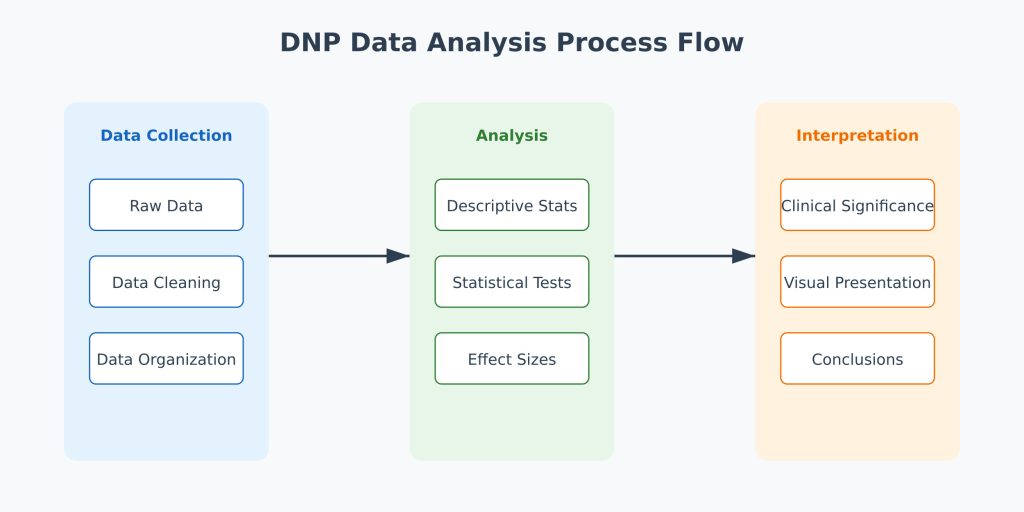
Tips for Effective Data Analysis Writing
- Clarity in Methods:
“We employed SPSS Version 27 for all statistical analyses. Significance was set at p<0.05, and effect sizes were calculated using Cohen’s d.” - Balanced Reporting:
“While the intervention showed significant benefits, 12% of participants did not achieve target blood pressure, warranting subgroup analysis.” - Visual Impact:
“Key findings are presented in three formats:
- Run charts for temporal trends
- Box plots for distribution analysis
- Bar graphs for comparative outcomes”
Common Analysis Challenges
Address potential issues transparently:
“Missing data (4% of BP readings) were handled using multiple imputation methods. Sensitivity analyses confirmed that results remained significant under various assumptions about missing data.”
Statistical Reporting Examples
Strong Example:
“The intervention group (n=45) showed significantly lower systolic BP (M=128.5, SD=8.7) compared to the control group (n=43, M=142.3, SD=11.2), t(86)=6.42, p<0.001, d=1.38.”
Weak Example (Avoid):
“The intervention worked better than control (p<0.05).”
Your data analysis section should:
- Demonstrate methodological rigor
- Present clear, reproducible results
- Connect findings to clinical practice
- Support project conclusions
- Guide future implementation
Remember: Balance statistical significance with clinical relevance throughout your analysis presentation.
Discussion Section Guide
Step 7: Writing the Discussion Section of Your DNP Capstone Project
Structure and Components (Word Count: 1,500-2,000 words)
1. Summary of Key Findings (20% – 300-400 words)
Begin with a clear restatement of your primary findings:
Example Opening:
“This quality improvement initiative demonstrated a significant reduction in hospital-acquired pressure injuries (HAPI) following the implementation of a nurse-led turning protocol. The HAPI rate decreased from 12% to 3.5% (p<0.001), exceeding our target goal of 50% reduction.”
Key Elements to Include:
* Primary outcome results
* Secondary findings
* Statistical significance
* Clinical significance
* Relationship to objectives2. Interpretation of Results (25% – 375-500 words)
Compare your findings with existing literature:
Example Paragraph:
“Our findings align with Johnson et al. (2023), who reported a 65% reduction in HAPI rates following implementation of a similar protocol. However, our study achieved results more quickly (8 weeks vs. 12 weeks), possibly due to our additional staff education component.”
Structure Your Interpretation:
| Component | Content | Example |
|---|---|---|
| Literature Comparison | Compare to similar studies | “Our 70% reduction exceeds previous studies” |
| Context Analysis | Explain unique factors | “Strong leadership support enhanced implementation” |
| Expected vs. Actual | Compare to predictions | “Results exceeded expected 50% reduction” |
3. Unexpected Findings (15% – 225-300 words)
Address surprising results honestly:
Example:
“Unexpectedly, night shift compliance (95%) exceeded day shift compliance (82%). Staff interviews revealed that lower patient-to-nurse ratios during night shifts facilitated better protocol adherence.”
Include:
* Surprising outcomes
* Implementation challenges
* Unexpected benefits
* Adaptation strategies
* Staff feedback4. Practice Implications (25% – 375-500 words)
Detail the impact on:
- Clinical Practice:
“Results support standardizing the turning protocol across all medical-surgical units, with potential annual cost savings of $245,000.”
- Policy Changes:
“Findings justify updating hospital-wide skin assessment policies to include mandatory two-person turning assessments.”
- Education:
“Implementation success suggests incorporating protocol training into new staff orientation.”
- Future Research:
“Results indicate need for investigation into sustainability strategies.”
5. Limitations & Future Directions (15% – 225-300 words)
Address constraints honestly:
Example Structure:
Limitations:
* Single-site implementation
* Short follow-up period
* Staff turnover impact
* Resource constraints
Future Directions:
* Multi-site validation
* Long-term follow-up
* Cost-effectiveness analysis
* Protocol refinementsDNP Discussion Section Writing Tips
Strong Discussion Examples:
- Connecting Findings to Practice:
✓ “The 70% reduction in HAPI rates translates to 45 prevented injuries annually, representing $180,000 in cost savings and improved patient outcomes.” - Addressing Limitations:
✓ “While our single-site study limits generalizability, detailed protocol documentation and implementation strategies support replication in similar settings.” - Future Implications:
✓ “Results suggest potential for system-wide implementation, with projected annual savings of $1.2 million across our healthcare system.”
Weak Discussion Examples to Avoid:
❌ “The intervention worked well.”
❌ “More research is needed.”
❌ “Results were significant.”
Discussion Section Checklist
Quality Criteria:
- [ ] Summarizes key findings clearly
- [ ] Links to existing literature
- [ ] Addresses all objectives
- [ ] Explains unexpected findings
- [ ] Discusses implications
- [ ] Acknowledges limitations
- [ ] Suggests future directions
- [ ] Provides specific recommendations
DNP Discussion Section Final Tips
- Organization:
- Use clear headings
- Maintain logical flow
- Support claims with evidence
- Link back to objectives
- Writing Style:
- Be specific
- Use active voice
- Provide examples
- Stay objective
- Content Focus:
- Emphasize clinical significance
- Address stakeholder interests
- Consider sustainability
- Suggest concrete actions
Remember: Your discussion section should tell the story of what your findings mean for clinical practice and future research.
Structure your discussion using these elements:
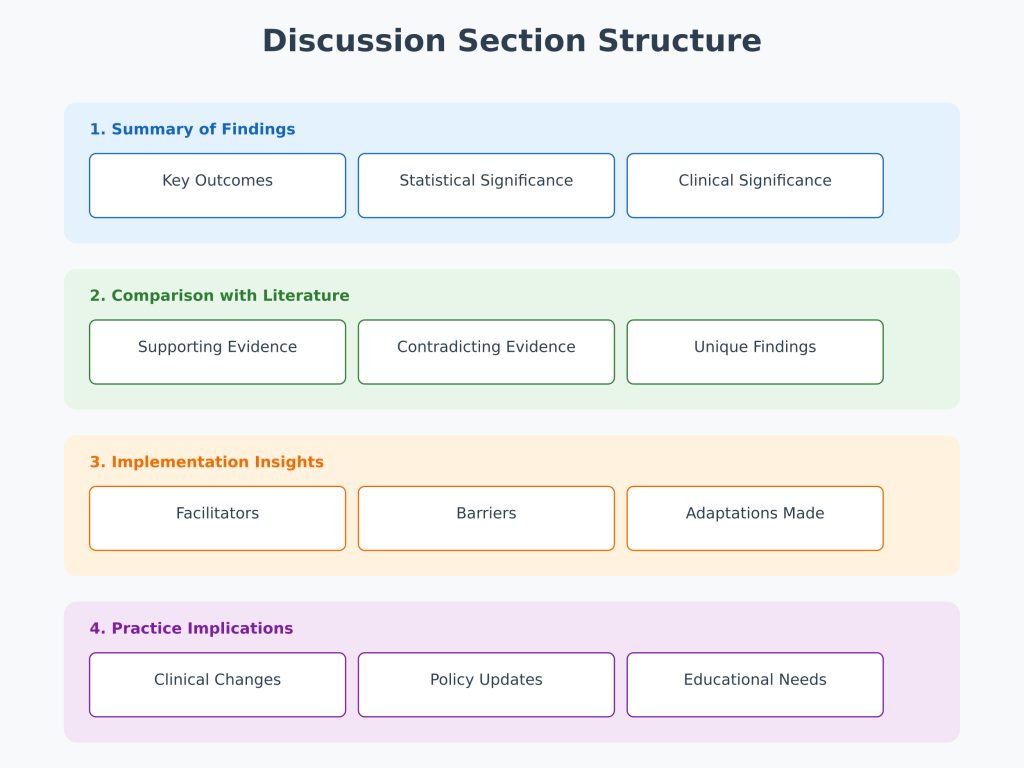
Example Discussion Paragraph:
“The implementation of the nurse-led screening protocol resulted in a significant increase in screening compliance (50% improvement, p<0.001) and early detection rates (16% improvement, p<0.001). These findings align with Smith et al. (2022), who reported similar improvements in rural settings. However, our study demonstrated additional benefits in reduced referral times, suggesting that standardized protocols may have broader system-level impacts.”
Step 8: Writing a Strong Conclusion for Your DNP Capstone Project
Structure and Components (Word Count: 750-1000 words)
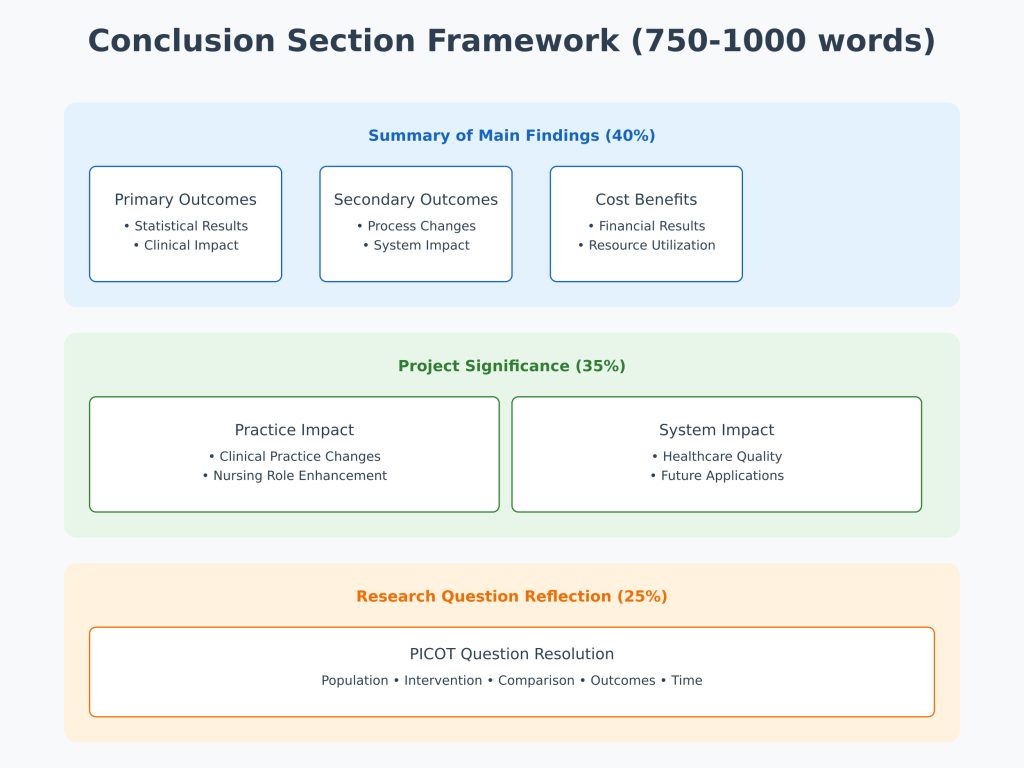
1. Summary of Main Findings (40% of conclusion)
Begin with a powerful synthesis of your key results:
Example Opening:
“This evidence-based practice initiative demonstrated that implementing a nurse-led diabetes education protocol resulted in three significant outcomes: (1) a 2.1% reduction in A1C levels across 85% of participants, (2) a 60% improvement in diabetes self-management scores, and (3) a 45% decrease in diabetes-related emergency department visits.”
Key Elements to Include:
Primary Outcomes:
* Statistical results
* Clinical impacts
* Patient outcomes
* Cost implications
Secondary Outcomes:
* Process improvements
* Staff development
* System changes
* Unexpected benefits2. Project Significance (35% of conclusion)
Address significance at multiple levels:
| Level | Impact | Example Statement |
|---|---|---|
| Patient Care | Direct outcomes | “Improved glycemic control for 156 patients” |
| Nursing Practice | Process changes | “Standardized evidence-based protocols” |
| Healthcare System | System impact | “Reduced ED visits by 45%” |
| Cost Effectiveness | Financial results | “Annual savings of $280,000” |
Example Significance Paragraph:
“This project’s significance extends beyond individual patient outcomes. The standardization of diabetes education has transformed our primary care practice, providing nurses with evidence-based tools for patient education while reducing healthcare costs through decreased emergency department utilization.”
3. Research Question Reflection (25% of conclusion)
Link back to your original PICOT question:
Example Structure:
Original Question:
"In adult diabetic patients (P), how does a nurse-led structured education program (I) compared to standard care (C) affect A1C levels and self-management behaviors (O) over six months (T)?"
Address Each Component:
* Population: Results specific to target group
* Intervention: Effectiveness of approach
* Comparison: Improvements over baseline
* Outcomes: Achievement of goals
* Time: Timeline observationsDNP Capstone Project Writing Tips for Strong Conclusions
DO:
- Synthesize, don’t summarize
- Emphasize clinical significance
- Link to the broader healthcare context
- Provide specific recommendations
- End with strong future implications
DON’T:
- Introduce new information
- Include detailed statistics
- Discuss limitations
- Make unfounded claims
- End weakly or uncertainly
Sample Conclusion Paragraphs
Strong Opening:
“This quality improvement initiative has definitively demonstrated that structured nurse-led diabetes education can transform patient outcomes in primary care settings. Through systematic implementation of evidence-based protocols, we achieved significant improvements in glycemic control, patient self-management, and healthcare utilization.”
Strong Middle:
“The project’s significance lies in its demonstration of how systematic changes in nursing practice can lead to measurable improvements in patient outcomes. By standardizing diabetes education and empowering nurses with evidence-based tools, we created a sustainable model for chronic disease management.”
Strong Ending:
“This initiative has successfully answered our research question by demonstrating that nurse-led structured education significantly improves both clinical outcomes and patient self-management capabilities. These findings provide a foundation for expanding this model to other chronic disease management programs within primary care settings.”
DNP Essential Elements Checklist
✓ Main Findings Summary:
- [ ] Primary outcomes clearly stated
- [ ] Key statistics synthesized
- [ ] Clinical impact emphasized
- [ ] Patient benefits highlighted
✓ Significance Discussion:
- [ ] Practice implications
- [ ] System impact
- [ ] Cost benefits
- [ ] Future potential
✓ Research Question Reflection:
- [ ] PICOT elements addressed
- [ ] Goals achievement discussed
- [ ] Implementation insights
- [ ] Future directions indicated
Your conclusion should leave readers with a clear understanding of your project’s value and its implications for future nursing practice.
Step 9: Writing the Recommendation Section for Your DNP Capstone Project
Structure and Components (Word Count: 750-1000 words)
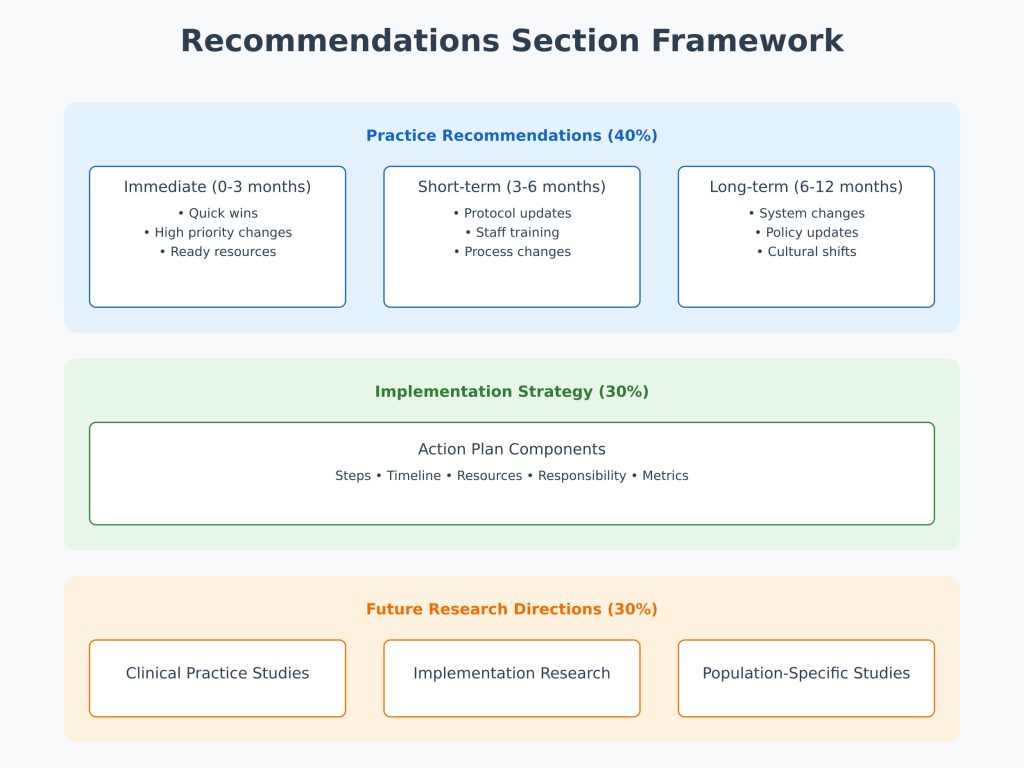
1. Practice Recommendations (40% of section)
Organize recommendations by impact level:
Immediate Implementation (0-3 months):
* High-priority changes
* Quick wins
* Resource-ready initiatives
Short-term Changes (3-6 months):
* Protocol updates
* Staff training needs
* Process modifications
Long-term Initiatives (6-12 months):
* System-wide changes
* Policy developments
* Cultural shiftsExample Format:
| Timeline | Recommendation | Resources Needed | Expected Impact |
|---|---|---|---|
| Immediate | Implement a standardized assessment tool | Electronic template | 30% efficiency increase |
| Short-term | Create a quality monitoring system | Education materials | 80% staff competency |
| Long-term | Create quality monitoring system | Data tracking system | Sustainable compliance |
2. Implementation Strategy (30% of section)
Detail the “how” of your recommendations:
Strong Example:
“To implement the standardized assessment protocol:
- Week 1-2: Upload electronic template to EMR
- Week 3-4: Conduct staff training sessions
- Week 5: Begin pilot implementation
- Week 6-8: Gather feedback and adjust
- Week 9-12: Full implementation with monitoring”
Include Action Plans:
For Each Recommendation:
* Specific steps
* Timeline
* Resource requirements
* Responsible parties
* Success metrics3. Future Research Directions (30% of section)
Structure research recommendations systematically:
- Clinical Practice Studies:
* Effectiveness studies
* Cost analysis research
* Patient outcome tracking
* Quality metrics evaluation- Implementation Research:
* Barrier analysis
* Facilitator identification
* Process improvement studies
* Sustainability assessment- Population-Specific Research:
* Demographic variations
* Cultural adaptations
* Setting modifications
* Special populationsDNP Project Recommendation Section Checklist
✓ Practice Recommendations:
- [ ] Evidence-based suggestions
- [ ] Clear implementation steps
- [ ] Resource requirements
- [ ] Timeline expectations
- [ ] Success metrics
✓ Implementation Strategy:
- [ ] Detailed action plans
- [ ] Resource allocation
- [ ] Staff engagement
- [ ] Monitoring methods
- [ ] Evaluation criteria
✓ Research Directions:
- [ ] Gap identification
- [ ] Study proposals
- [ ] Methodology suggestions
- [ ] Population focus
- [ ] Timeline considerations
Writing Examples
Strong Recommendation Example:
“Implement a standardized diabetic foot assessment protocol in primary care, including:
- Weekly nurse-led screenings
- Electronic documentation template
- Patient education materials
- Provider notification system
Expected impact: 50% reduction in diabetic foot complications within 6 months.”
Weak Recommendation (Avoid):
❌ “More diabetic foot assessments should be done.”
Strong Implementation Strategy:
“Phase 1 (Weeks 1-4):
- Develop electronic template
- Create training materials
- Identify super users
- Schedule staff training
Phase 2 (Weeks 5-8):
- Conduct training sessions
- Begin pilot implementation
- Gather feedback
- Make adjustments
Phase 3 (Weeks 9-12):
- Full implementation
- Monitor compliance
- Track outcomes
- Report results”
Strong Research Direction:
“Future studies should examine:
- Long-term sustainability of the protocol
- Cost-effectiveness across different settings
- Impact on patient outcomes beyond 12 months
- Cultural adaptations for diverse populations”
Common Pitfalls to Avoid
- Vague Recommendations:
❌ “Improve patient care”
✓ “Implement twice-weekly nurse-led assessments” - Unrealistic Timelines:
❌ “Complete all changes in one month”
✓ “Phase implementation over 12 weeks” - Resource Oversight:
❌ “Begin immediately”
✓ “Start after staff training and resource allocation”
Your recommendations should provide a clear, actionable roadmap for implementing and sustaining positive change in clinical practice.
Step 9: Organizing Your DNP Capstone Project Appendices
Structure and Organization
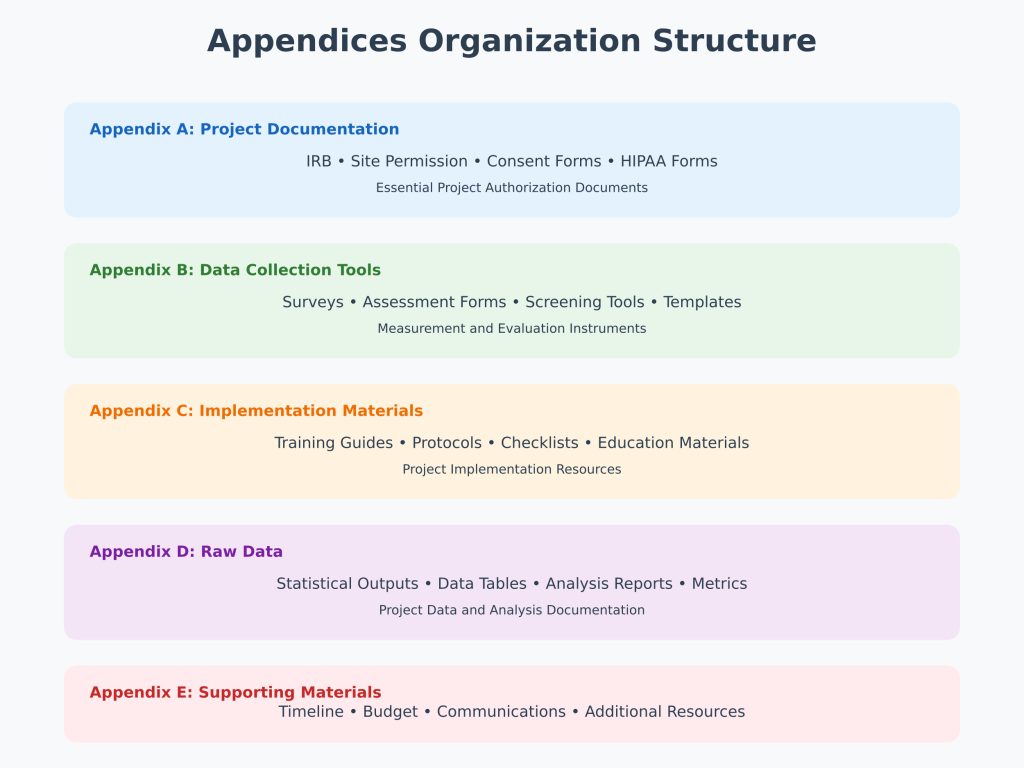
Required Components (Listed in Order)
Appendix A: Project Materials
* IRB Approval Letter
* Site Permission Documentation
* Informed Consent Forms
* HIPAA Authorization Forms
Appendix B: Data Collection Tools
* Survey Instruments
* Assessment Forms
* Screening Tools
* Documentation Templates
Appendix C: Implementation Materials
* Educational Materials
* Training Guides
* Protocol Documents
* Implementation Checklists
Appendix D: Raw Data
* Statistical Outputs
* Data Tables
* Analysis Reports
* Quality Metrics
Appendix E: Supporting Documents
* Project Timeline
* Budget Information
* Communication Plans
* Marketing MaterialsDNP Project Quality Assurance Checklist
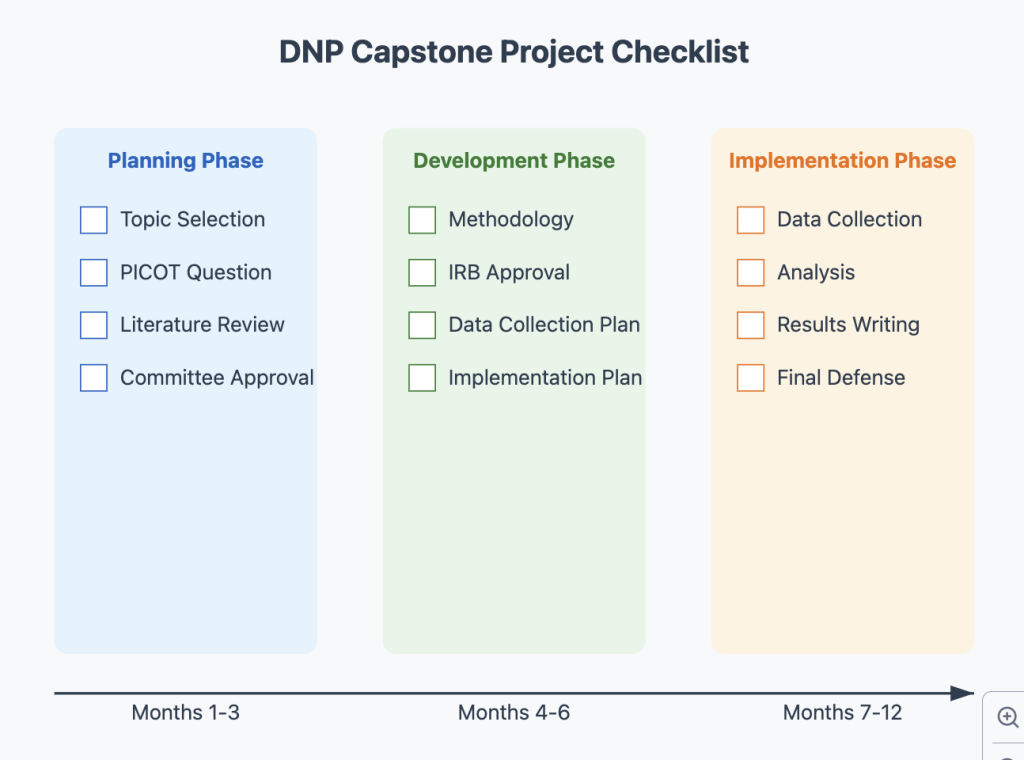
What is a DNP Capstone Project?
The DNP capstone project is a culminating experience for DNP students within the Doctor of Nursing Practice program. It is an extensive and comprehensive project that demonstrates the student’s ability to apply knowledge gained throughout the DNP program to real-world issues in nursing practice. The project may focus on evidence-based practice, quality improvement, or research initiatives that aim to enhance patient outcomes or resolve specific problems in clinical practice.
What are the key components of a DNP Capstone Project?
A successful DNP capstone project typically includes several key components: a thorough literature review, identification of a clinical problem, project objectives, a detailed methodology for implementation, evaluation metrics, and a discussion of the project outcomes. Adhering to DNP essentials during the capstone writing process ensures that the project meets academic and professional standards.
How do I select a DNP Capstone Project topic?
Selecting a project idea is a critical step in the capstone writing process. Begin by identifying areas within your nursing practice that interest you or where you see potential for improvement. Consider current challenges in healthcare, gaps in evidence-based practice, or needs in your community. Once you have a list of potential project ideas, discuss them with your capstone committee to refine your focus.
What is the process for writing a DNP Capstone Project?
The capstone writing process is a structured approach to developing your final project. It generally involves the following steps: selecting a topic, conducting a systematic review of relevant literature, designing the project, implementing it in a clinical setting, evaluating the outcomes, and compiling the findings into a comprehensive report. Following a step-by-step guide to writing can simplify this process and ensure that you meet all necessary requirements.
How can I ensure my DNP Capstone Project is evidence-based?
To ensure your DNP capstone project is evidence-based, conduct a systematic review of peer-reviewed articles and current guidelines related to your topic. Integrating high-quality research into your project design and implementation phases will strengthen your project and its potential impact on patient outcomes. Collaborating with faculty or mentors who specialize in evidence-based practice can also provide
